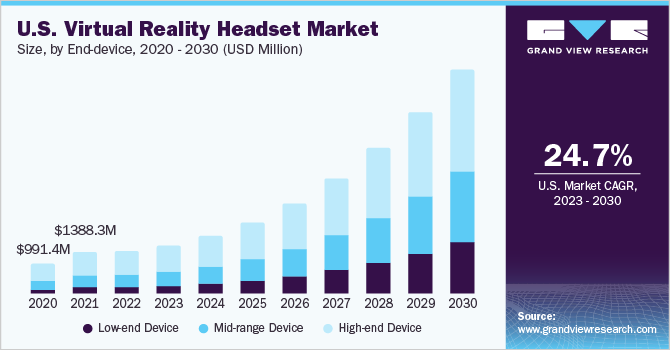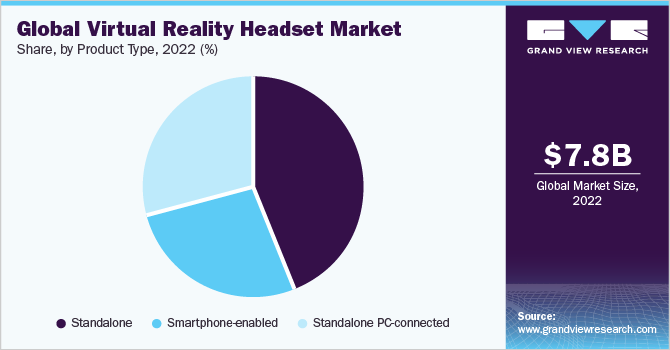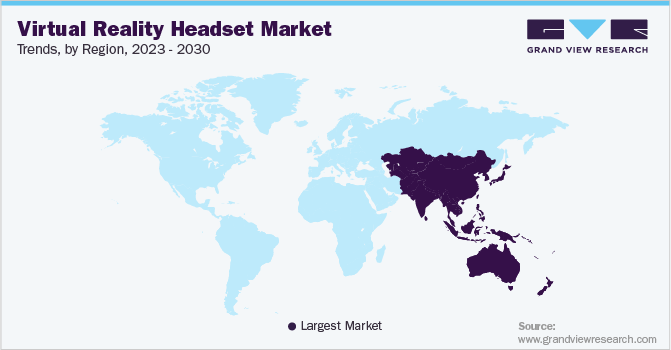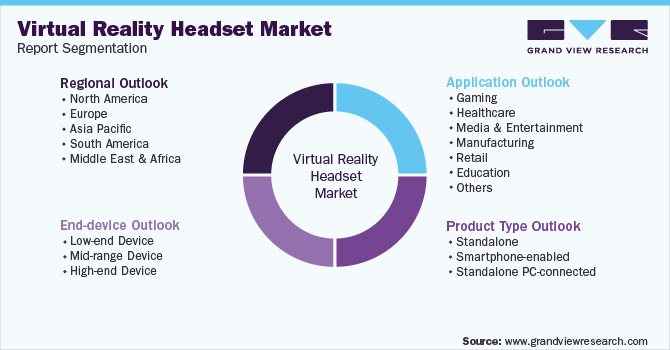- Home
- »
- Next Generation Technologies
- »
-
Virtual Reality Headset Market Share & Growth Report, 2030GVR Report cover
![Virtual Reality Headset Market Size, Share & Trends Report]()
Virtual Reality Headset Market Size, Share & Trends Analysis Report By End-device (Low-end, Mid-range, High-end), By Product Type (Standalone, Smartphone-enabled), By Application, By Region, And Segments Forecasts, 2023 - 2030
- Report ID: GVR-4-68038-030-9
- Number of Pages: 150
- Format: Electronic (PDF)
- Historical Range: 2018 - 2021
- Industry: Technology
Report Overview
The global virtual reality headset market size was valued at USD 7.77 billion in 2022 and is expected to grow at a compound annual growth rate (CAGR) of 30.6% from 2023 to 2030. The extensive application of virtual reality technology in the retail and manufacturing sectors is driving market growth. Moreover, the growing demand for gaming consoles is another factor driving the growth of industry. Virtual reality technology has a vast potential to be used in a broad range of applications, such as medical training, industrial prototyping, and education. The growing consumer investments in this technology along with enterprises are expected to fuel the product demand over the forecast period. The emerging trends in virtual reality technology have a direct impact on the developments in the virtual reality headset industry.

Furthermore, the integration of machine learning and Artificial Intelligence (AI) into virtual reality is likely to augment the product demand. The prominent players in the market are constantly investing in R&D for the development of state-of-the-art devices. In addition, during the Covid-19 pandemic, a large number of companies moved to online platforms to continue their business processes. The rising implementation of virtual reality technology in virtual events, which helps organizations to reach their target customers in their comfort zones by offering a life-like experience of their products and services, is further driving the growth of the market.
The growth in product adoption in the entertainment and gaming industries is enhancing the demand for VR-enabled Head-Mounted Devices (HMDs). Companies are constantly offering innovative devices to give unparalleled immersive experiences across VR entertainment. For instance, in November 2022, Facebook Technologies, LLC (Oculus) launched the XTADIUM application in their Meta Quest, giving an immersive sports experience in 180-degree VR footage of up to 8K quality. The key players in the market are focusing on integration of latest technological advancements to gain a competitive edge and improve their product offerings.
The growing trend of the virtual reality domain is becoming increasingly social and collaborative, along with the rapid penetration of smartphones is anticipated to offer various growth opportunities to the market. The benefits offered by the VR devices, such as the creation of a realistic world, immersive experience, profound visualization, and accessibility to experience different environments, are boosting the market growth. These devices have witnessed a high demand from various industrial sectors, especially for teaching and learning activities, during the Covid-19 pandemic. For instance, the U.K. government, with the help of VR headsets, trained its trauma medical professionals for the medical procedure. Likewise, the National Aeronautics and Space Administration (NASA) deployed VR technology to provide a Virtual Space Station (VSS), a suite of interactive computer-delivered treatment programs, and interactive behavioral health training.
The practical application of virtual reality technology in industries, such as healthcare, real estate, education, automotive, and retail, among others, is helping users in attaining efficient results, which is expected to fuel the market growth during the forecast period. In addition, key automotive industry companies, such as Jaguar Land Rover (JLR) and BMW, have been using virtual reality and its application for years. These companies use the technology to enhance and improve early engineering, and design reviews to check their vehicles' object obscuration and visual design.
End-device Insights
The high-end device segment accounted for the largest revenue share of over 57% in 2022 and is expected to retain its dominance over the forecast period. The advanced features of these devices, including high-quality visual effects, self-tracking, and elevated performance, are expected to drive the segment growth. High-end devices are majorly used in big corporations to provide better-quality service to their customers and employees. These devices are majorly enclosed with the latest & advanced technologies that offer improved involvement and high resolution to the viewers. Continuous investments in high-end devices by prominent players, such as HP Inc.; Facebook Technologies, LLC (Oculus); and Google LLC, are likely to augment their demand over the forecast years.
The low-end device segment is anticipated to exhibit the highest CAGR of around 35.3% from 2023 to 2030. This growth can be attributed to the benefits of these devices, such as lower costs and considerable immersive experience. The low-end devices are affordable and accessible to common people who are only interested in experiencing the basic VR technology. In addition, users can use their smartphone as a sensor or display and place their smartphone into the holder, and it starts generating virtual reality. This is also expected to fuel the demand for low-end devices over the forecast period.
Product Type Insights
The standalone product type segment accounted for the largest revenue share of over 44% in 2022 and is anticipated to retain its dominance from 2023 to 2030. A standalone device offers a high-quality experience at an affordable price. Its fundamental feature is the integration of various mechanisms, including processing control and hardware into a singular system. The key players offer various application-oriented devices with different features and price ranges which is driving the segment growth.

The smartphone-enabled product type segment is expected to exhibit a significant CAGR of 33.1% during the forecast period. The segment growth can be attributed to the rising penetration of advanced VR-enabled smartphones with the amalgamation of 3D technology and AI. Moreover, the ease in accessibility and large-scale availability of these virtual reality headsets for smartphone users are expected to drive the segment growth during the forecast period.
Application Insights
The gaming segment accounted for the largest revenue share of over 30% in 2022 and is anticipated to dominate the global market over the forecast period. Moreover, Gaming VR headsets are equipped with advanced technologies that can even track eye movements and transmit them to the game for a better experience. This, in turn, is projected to drive the segment growth during the forecast period. Gamers have an elevated average price outlay for transforming their gaming consoles or desktops compared to users that are not indulged in gaming. This has encouraged the firms to capitalize on the VR headset games within the reasonable price range for gamers.
The education segment is anticipated to register the fastest CAGR of 33.6% from 2023 to 2030. This is attributed to the increased product deployment in educational institutions and medical schools. Moreover, the advancements in the healthcare sector due to virtual reality technology, along with favorable government regulations for facility enrichment, is promoting the segment growth. The augmented use of these headsets for providing training to medical students and assisting medics and surgeons in patient treatment, robotic surgeries, mental health & psychological therapies, and pain management & physical therapies is further driving the healthcare segment growth.
Regional Insights
Asia Pacific is expected to register highest CAGR of over 32.9% from 2023 to 2030, owing to the increased digitalization and virtual reality technology developments, particularly in the gaming and entertainment sector. Within the regional market, China captured the largest revenue share. This is attributed to the advent of 5G and policy support for virtual reality progress from the government of China. The major companies in the region are widely utilizing virtual reality technology for several purposes, thus contributing to the regional market growth. For instance, in November 2022, China released their plan dedicated to virtual reality, under which the region is planning to ship over 25 million devices with a total value of over USD 45 million by the end of 2026.

North America accounted for a significant revenue share in 2022 owing to the high adoption of VR technology in the region due to high disposable income levels and weakening prices of headsets with screens and processors. The U.S. is a major contributor to the regional market growth owing to the presence of key players, such as Microsoft Corporation, Google LLC, and Facebook Technologies, LLC (Oculus), and their large-scale investments in VR technology.
Europe is expected to witness considerable developments in the market due to the substantial integration of smart devices, such as the deployment of VR headsets in various industries, including defense, entertainment, and education, to improve and develop visual experience. The increasing adoption of VR technology in amusement parks, cafes, gaming arcades, and exhibitions is positively impacting the regional market growth as well.
Key Companies & Market Share Insights
Leading companies are constantly investing in R&D for the development of cost-effective devices that offer high quality experience and can be utilized by various end-use industries. Meta Quest Pro, Meta Quest 2, HTC VIVE XR Elite, HTC VIVE Flow, and HTC VIVE Pro 2 Headset are some of the VR headsets that are prominent among several industry sectors. The significant expansion of the market is expected to be supported by gaming consoles from Nintendo, SEGA, and Atari, Inc., among others. Continuous investments in the research & development of virtual reality technology by industry participants are expected to boost the market growth over the forecast period.
The high revenues from the gaming sector guided the virtual reality device manufacturers to capitalize on the virtual reality headset segment by offering related software, hardware, and content services. Many businesses have been adopting several innovative technologies, such as Blu-ray, 4K, motion sensing, self-tracking, HD quality video, and Six Degrees of Freedom (6DoF), to cater to the changing customer demands. Moreover, M&A and partnerships with domestic firms are among the foremost stratagems implemented by the global industry players. For instance, in January 2023, Facebook Technologies, LLC (Oculus) expanded their partnership with NBA and WNBA as league's official virtual reality headset partner. This partnership is expected to offer professional basketball experience in a virtual reality environment. Some major players operating in the global virtual reality headset market include:
-
Carl Zeiss AG
-
Facebook Technologies, LLC (Oculus)
-
Google LLC
-
HTC Corporation
-
LG Electronics, Inc.
-
Microsoft Corporation
-
Razer Inc.
-
FOVE, Inc.
-
Valve Corporation
-
HP Inc.
Virtual Reality Headset Market Report Scope
Report Attribute
Details
Market size value in 2023
USD 9,201.6 million
Revenue forecast in 2030
USD 59.63 billion
Growth rate
CAGR of 30.6% from 2023 to 2030
Base year for estimation
2022
Historical data
2018 - 2021
Forecast period
2023 - 2030
Quantitative units
Revenue in USD million and CAGR from 2023 to 2030
Report coverage
Revenue forecast, company ranking, competitive landscape, growth factors, and trends
Segments covered
End-device, product type, application, region
Regional scope
North America; Europe; Asia Pacific; South America; Middle East & Africa
Country scope
U.S.; Canada; Mexico; U.K.; Germany; France; Italy; Spain; Russia; Benelux; Nordic Countries; China; Japan; India; South Korea; Australia; Indonesia; Brazil; Argentina; UAE; Saudi Arabia; Egypt; South Africa; Nigeria
Key companies profiled
Carl Zeiss AG; Facebook Technologies, LLC (Oculus); Google LLC; HTC Corporation; LG Electronics, Inc.; Microsoft Corporation; Razer Inc.; FOVE, Inc.; Valve Corporation; HP Inc.
Customization scope
Free report customization (equivalent to up to 8 analysts working days) with purchase. Addition or alteration to country, regional & segment scope.
Pricing and purchase options
Avail customized purchase options to meet your exact research needs. Explore purchase options
Global Virtual Reality Headset Market Report Segmentation
This report forecasts revenue growth at the global, regional, and country levels and analyzes the latest market trends in each of the sub-segments from 2018 to 2030. For this study, Grand View Research has segmented the global virtual reality headset market report based on end-device, product type, application, and region:

-
End-device Outlook (Revenue, USD Million, 2018 - 2030)
-
Low-end Device
-
Mid-range Device
-
High-end Device
-
-
Product Type Outlook (Revenue, USD Million, 2018 - 2030)
-
Standalone
-
Smartphone-enabled
-
Standalone PC-connected
-
-
Application Outlook (Revenue, USD Million, 2018 - 2030)
-
Gaming
-
Healthcare
-
Media & Entertainment
-
Manufacturing
-
Retail
-
Education
-
Telecommunications
-
Others
-
-
Regional Outlook (Revenue, USD Million, 2018 - 2030)
-
North America
-
U.S.
-
Canada
-
Mexico
-
-
Europe
-
U.K.
-
Germany
-
France
-
Italy
-
Spain
-
Russia
-
Benelux
-
Nordic Countries
-
-
Asia Pacific
-
China
-
Japan
-
India
-
South Korea
-
Australia
-
Indonesia
-
-
South America
-
Brazil
-
Argentina
-
-
Middle East & Africa
-
UAE
-
Saudi Arabia
-
Egypt
-
South Africa
-
Nigeria
-
-
Frequently Asked Questions About This Report
b. The global virtual reality headset market size was estimated at USD 7.77 billion in 2022 and is expected to reach USD 9,201.6 million in 2023.
b. The global virtual reality headset market is expected to grow at a compound annual growth rate of 30.6% from 2023 to 2030 to reach USD 59.63 billion by 2030.
b. Asia Pacific dominated the VR headset market with a share of over 41% in 2022. This is attributable to continuing technological advancements and rising demand for high-end electronic devices.
b. Some key players operating in the virtual reality headset market include HTC Corporation; Facebook, Inc.; Google LLC; Microsoft Corporation; and Razer Inc.
b. Key factors that are driving the VR headset market growth include technological advancements, and a wide range of applications in healthcare, education, and industrial prototyping.
Share this report with your colleague or friend.
![gvr icn]()
NEED A CUSTOM REPORT?
We can customize every report - free of charge - including purchasing stand-alone sections or country-level reports, as well as offer affordable discounts for start-ups & universities. Contact us now
![Certified Icon]()
We are GDPR and CCPA compliant! Your transaction & personal information is safe and secure. For more details, please read our privacy policy.
We are committed towards customer satisfaction, and quality service.
"The quality of research they have done for us has been excellent."





